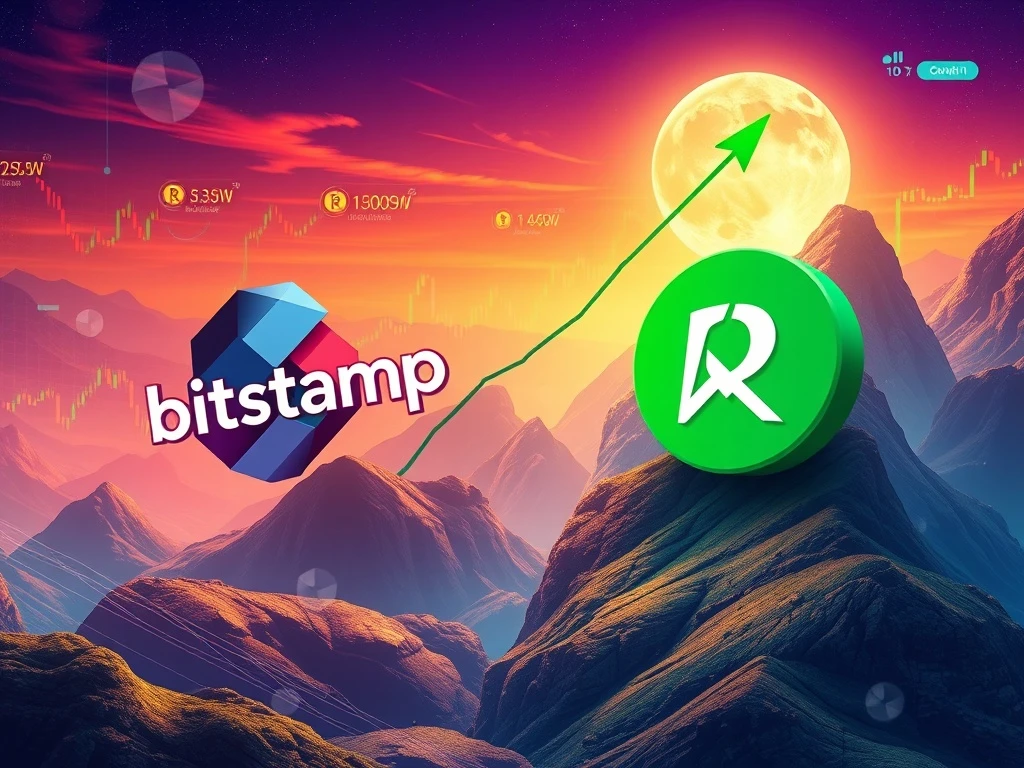Bitstamp Triumphs: Astonishingly Surpasses Robinhood Crypto Volumes in August

The cryptocurrency landscape constantly shifts, with market dynamics often surprising even seasoned observers. A significant development emerged in August, as Bitstamp, a long-standing crypto exchange, remarkably surpassed Robinhood’s crypto trading volumes. This unexpected flip signals evolving market preferences and strategic impacts within the digital asset space, capturing the attention of investors and industry analysts alike.
Bitstamp’s Remarkable Ascent in Crypto Trading Volume
Bitstamp experienced a notable surge in August. The exchange reported a substantial 21% increase in its crypto trading volume, reaching an impressive $14.4 billion. This achievement marks a pivotal moment. It represents the first time Bitstamp has exceeded Robinhood’s volumes since its acquisition.
Conversely, Robinhood witnessed a decline in its cryptocurrency activities. According to a recent company report, Robinhood’s nominal crypto volumes fell by 18% in August compared to July. Their total reached only $13.7 billion. Data indicates this volume had shown a downward trend for Robinhood since late 2023, following a record quarter. Although it ticked up briefly in July, the subsequent slump in August was clear. This shift highlights a competitive environment where platforms constantly vie for market share.
Robinhood’s Strategic Moves and Tokenization Ambitions
Robinhood completed its acquisition of Bitstamp on June 2. This strategic move, valued at $200 million, significantly expanded Robinhood’s client base. It added over 5,000 institutional clients and an additional 50,000 retail customers to their ecosystem. The integration aims to bolster Robinhood’s presence in the broader digital asset economy.
Bitstamp is now poised to play a crucial role in Robinhood’s future endeavors. Specifically, it will be central to the company’s ambitions in the real-world asset tokenization market. Renamed “Bitstamp by Robinhood,” the exchange connects seamlessly with Robinhood Legend and its Smart Exchange Routing offering. This integration simplifies trading across both platforms, enhancing user experience and operational efficiency.
Despite the individual shifts, combined crypto trading volumes for Bitstamp and Robinhood saw a slight decrease. They fell by 2.1% month-over-month. Nevertheless, Robinhood’s total assets demonstrated resilience, rising 2% over August to reach $304 billion. Approximately $41 million of these assets were held in crypto, underscoring the platform’s diverse financial offerings.
Analyzing Broader Crypto Market Sentiment
The broader crypto market experienced a relatively flat August. Trading volumes saw only a minor rise, and prices largely concluded the month where they began. This period of stagnation prompts questions about underlying market drivers.
Experts offer various perspectives on why crypto trading on Robinhood may have stalled. Ryan McMillin, CEO of Australian crypto fund management firm Merkle Tree Capital, pointed to seasonality. He noted that as a North America-based platform, trading could have been affected by the summer holiday period. This factor often leads to reduced activity across financial markets.
Looking more broadly, McMillin observed that crypto market sentiment has been “relatively quiet” recently. The market awaits key macro signals. Particularly, investors are watching whether recent weakening jobs and inflation data will justify a rate cut, and if so, to what extent. He highlighted the shift in Federal Reserve policy: “Trump has been pushing for lower rates while Jerome Powell has dug his heels in, now that looks to have changed.”
Despite the current quietude, both McMillin and CK Zheng, a founder and chief investment officer of ZX Squared Capital, anticipate a surge in overall trading volume soon. They both expect crypto to reach new record highs before the year’s end. Zheng, furthermore, challenges the conventional four-year crypto cycle thesis. He suggests that the fourth quarter might not mark the peak of the current market cycle. His reasoning points to stronger institutional adoption, particularly with the advent of crypto exchange-traded funds (ETFs) and the increasing involvement of crypto treasury companies.
Robinhood’s Expanding Influence and Innovation
In other significant news, Robinhood recently debuted on the Standard & Poor’s 500 index. This inclusion brings another crypto-active company into America’s most tracked stock index. Edwin Mata, CEO of tokenization platform Brickken, commented on this development. He stated that “This movement expands the index’s exposure and connection to the digital asset economy.” Robinhood shares (HOOD) rallied over 16% on the day of the announcement, reflecting investor optimism. Notably, Robinhood’s inclusion came as Michael Saylor’s MicroStrategy was overlooked for the index.
Robinhood crypto also continues its innovation drive. Around early July, the company launched a new tokenization-focused layer 2 blockchain. This platform targets its customer base in the European Union, providing them access to US stocks. Additionally, Robinhood introduced perpetual futures in the EU, allowing eligible traders to access derivatives with up to three times leverage. Significantly, these trades will be routed through Bitstamp, the very crypto exchange it recently acquired. This strategic routing underscores the synergy between Robinhood’s new offerings and its acquired assets. The question of whether platforms like Robinhood or Kraken can truly decentralize their tokenized stocks remains a key industry debate.









